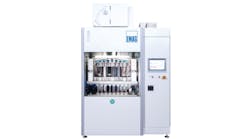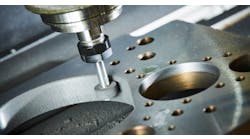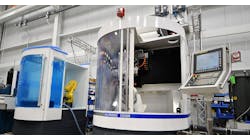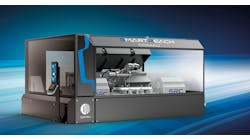2025 Outlook for Manufacturing Technology
More Improvement in US Machine Tool Orders
5-Axis Machining for Large Parts
Ferdinand Bernhofer GmbH is a midsized, owner-operated drop-forging business in Höhnhart, Austria, producing steel parts for heavy-duty vehicles and equipment. In that market segment, it pays to offer something more than forging.
"Our company specializes in drop forging in the weight range from 2.5 kg to 20 kg," according to Eng. Ferdinand Bernhofer, owner and managing director of technology. The work project involve mainly small to medium-sized orders in batches sized from 500 to 50,000 parts/year. Parts are delivered machined and ready for use, upon customer request.
The customers are manufacturers of commercial trucks and agricultural machinery, off-road vehicles (from construction machinery to dirt bikes), as well as general mechanical engineering companies and producers of hydraulic systems. A typical product is a drawbar "eye," a type of coupling used for hauling heavy vehicles, in railway vehicles, agricultural equipment, and industrial and recreational trailers.
Besides its high competency and efficiency in forging parts to customer satisfaction, Bernhofer GmbH works to assist its buyers in optimizing part design to ensure process compatibility. This includes finish-machining of forged parts.
Such parts are forged from quenched and tempered steel, chosen for its superior strength and toughness. That means that machining such parts demands high force. In addition, during machining such materials tend to form longer pieces of swarf, which are difficult to remove.
"When it comes to delivery, customers are increasingly expecting complete service packages from a single source," Bernhofer explained.
Frequently customers prefer to work with a single-source provider that will assume overall manufacturing responsibility, whether its custom finished parts or installation-ready modules. Not having to rely on and keep track of numerous suppliers allows a customer to concentrate on its core competencies. Bernhofer began expanding its range of services several years ago, and offering installation-ready machining as a standard service was a top priority.
This service, which the forging shop previously had outsourced, was to become a standard option. Bernhofer set out to find a machine-tool manufacturer capable of supplying systems that would be sturdy and powerful enough to handle three-shift machining of forged parts, often in high-strength, difficult to machine alloys. The parts to be machined would be combined in groups so that the systems could be changed over or retooled as quickly and smoothly as possible.
Another criterion was advanced automation capability, in order to conserve resources through 24/7 operation.
"The first project was a family of parts with six variants made of quenched and tempered steel, for motorcycle frames," explained Christian Stempfer, regional sales manager in Austria for Schwäbische Werkzeugmaschinen GmbH (SW). Bernhofer's goals were fully automatic machining and product change, with no tooling changeovers. The BA 322 horizontal machining center with two synchronous spindles from SW was selected on this basis. Bernhofer was so satisfied with the system that SW was presented with the forgers supplier award for 2016, the same year as the delivery.
"The mutual trust we have built on this foundation has led us to choose SW again for the next project," Bernhofer said recently. The next project involved machining particularly large drawbar eyes made of different variants of 42CrMo4. This task was made more difficult by the relatively large number of holes and fits that had to be machined, and further complicated by the need for cooling lubricant to drill the holes.
The type BA 722 milling machine selected for this purpose is designed and built similarly to the BA 322 already in use. The newer, and larger machining center, also with two spindles, was needed mainly because considerably greater quantities of steel are removed through machining than for the motorcycle parts.
BA 7-series milling centers are built with one, two, three or four synchronous spindles, for high-performance machining of cast iron or steel or forged steel workpieces. The spindles and rotary tables promise short "chip-to-chip times" and thus high productivity due to high acceleration rates and rapid traverse speeds. From a user perspective, the vertical positioning of the rotating/swiveling units of the pallet changer simplifies loading and unloading, while the horizontal machining optimizes swarf removal.
Two variants are available: one is equipped with a block spindle box, with a fixed spindle distance of 700 mm; while the other offers a more flexible design with variable spindle distance, freely programmable from 600 to 700 mm. This means a workpiece can be positioned on one side of a pallet at a distance of 300 to 600 mm, and on the other side at a distance of 350 to 700 mm. Thus, BA 7 series machines are ideal for medium and high-volume production of large-format, complex parts.
Machining each drawbar eye involves removing up to 3 kg of material, which may weigh up to 18 kg depending on the variant. Although the allowances range from 5 to 15 mm, no problems were reported for the workhorse BA 722. Its two spindles are quite capable of removing up to two metric tons of material in an hour of rough machining, even with a material as difficult to machine as QT steel. The BA 722 system also can be used for precision machining, for example in helical interpolation of semi-spheres for clutches.
"The support provided by SW was beyond impeccable," Bernhofer recalled. In the critical initial phase of the project, Stempfer in particular was determined to eliminate initial glitches and optimizing processes, … The technical service provided by the SW technicians and their supply of replacement parts left nothing to be desired."
The first system delivered proved to be such a success that a second BA 722 was ordered a short time later, because Bernhofer's customer's call-off orders had increased. Machine availability is excellent despite the high work load: "I was also so satisfied with the BA 722 that we have already begun discussing more extensive automation for the coming year," he confirmed.








